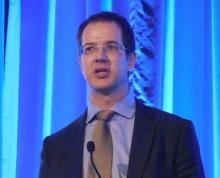The video associated with this article is no longer available on this site. Please view all of our videos on the MDedge YouTube channel.
NEW ORLEANS – U.S. clinicians prescribe opioid tablets to postsurgical patients too often and at too high a pill count, according to results from two independent studies that examined prescribing patterns and opioid use in patients following gynecologic surgery.
One of the studies also implemented an “ultrarestrictive” postsurgical opioid prescribing protocol for 337 patients at one U.S. center that did not allow the routine prescription at hospital dismissal of opioids to minimally invasive or outpatient surgery patients with no history of chronic pain. This approach cut opioid prescribing by 97%, compared with the historic rate from the preceding year while resulting in 96% of the patients reporting satisfaction with their treatment, Jaron E. Mark, MD, said at the annual meeting of the Society of Gynecologic Oncology.In addition, “setting preoperative expectations about pain management led to increased compliance at discharge,” said Dr. Mark, a gynecologic oncologist at Roswell Park Comprehensive Cancer Center in Buffalo, N.Y.
Findings from the second study, of 122 women who underwent gynecologic surgery at Women and Infants Hospital in Providence, R.I., showed that 32% did not use any opioids for pain following hospital discharge, and that opioid use during hospitalization was a significant predictor of postdischarge opioid needs. This finding provided a way to devise a new prescribing guide for postsurgical patients based on their opioid use while hospitalized, said Erica Weston, MD, a gynecologic oncologist at Johns Hopkins University, Baltimore.
The findings from both studies show that “if we educate patients, fewer opioids are needed for pain control” after gynecologic surgery, commented Sean C. Dowdy, MD, a professor of ob.gyn. and chair of gynecologic surgery at the Mayo Clinic in Rochester, Minn. “A large proportion of both minimally invasive surgery and laparotomy patients require no opioids after their hospital dismissal,” he noted as designated discussant for the two reports.“No question, we are overprescribing,” Dr. Dowdy said, and described a program he and his colleagues at Mayo recently put in place that capped routine opioid pill prescriptions following various surgeries based on historic patient needs. For example, most laparotomy patients receive a prescription for 10 opioid doses on discharge. Based on the first 6 months of this program, it’s on track to cut the annual number of opioid tablets prescribed to postsurgical patients at Mayo by 35,000 for all gynecologic surgeries and by 1.5 million tablets for all Mayo surgical subspecialties, he said.
But while he highlighted the need for widespread action to reduce the clear overprescribing that occurs, he also cautioned against underprescribing. “The goal is not less opioid prescribing, but more appropriate prescribing,” Dr. Dowdy declared.




